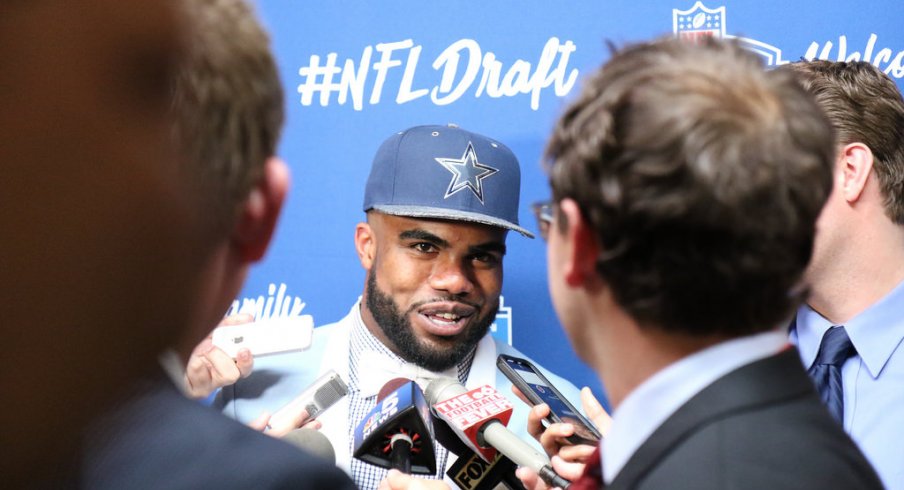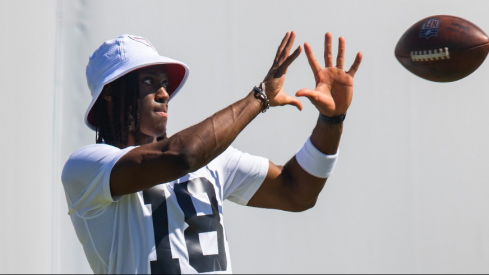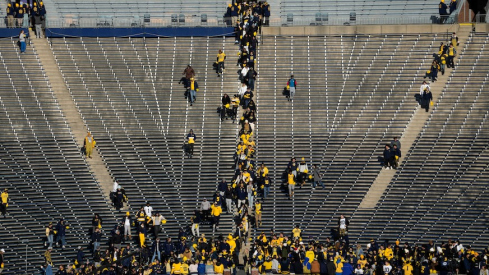In an instance of the draft-day stars aligning, the Dallas Cowboys’ selection of Ohio State tailback Ezekiel Elliott as the fourth overall pick in the 2016 NFL Draft looks like a perfect match for both sides.
Elliott’s selection caught exactly no one by surprise as the media, draft pundits, and fans had linked the talented tailback and America’s team to the number four spot in the months leading up to the draft. Passing on needs along the defensive line and in the secondary, Elliott’s selection signals a clear desire by the Cowboys to turbocharge an already strong running game with the consensus number one tailback in the 2016 class.
Consider the following sentence very carefully: Despite playing a large chunk of the season with journeymen quarterbacks Brandon Weeden, Matt Cassel, and Kellen Moore at the helm in place of injured starter Tony Romo, the Dallas ground game still managed to finish 9th in total rushing and 5th in yards per attempt (4.6).
There are several reasons the Elliott-Cowboys’ match is a dream scenario for both player and organization. The St. Louis product joins a team with established offensive playmakers in oft-injured quarterback Tony Romo and wide receiver Dez Bryant, running behind an offensive line featuring three selections to the 2016 Pro Bowl. In addition, the learning curve for a rookie running back is not as steep as other positions, particularly on first and second down when a premium is not placed on pass protection (although Elliott’s outstanding pass protection and receiving skills will make him an immediate three-down back).


Finally, and perhaps most importantly, Elliott’s role in the Dallas offense will not dramatically differ from what he was asked to do at Ohio State due to similarities in scheme.
Like OSU head coach Urban Meyer’s running game, the Dallas offense utilizes diverse philosophy featuring a variety of zone and gap-blocked concepts. While the concept and technique will be more detailed in the pros, a quick look at the tape shows much overlap between Meyer’s pro-style running game and that of Cowboys’ head coach Jason Garrett.
The Cowboys offense makes heavy use of Ohio State’s base run play, tight zone. Our first example shows the Urban Meyer-staple ‘Split Zone’, a variant of tight zone that utilizes the tight end to arc block the EMLOS (End Man on Line of Scrimmage).



The only major difference between the concepts is the elimination of the quarterback read and bootleg at the pro level. NFL quarterbacks are simply too valuable a commodity to risk an injury for a six-yard gain. This will help Elliott’s numbers as he will receive the ball every time the concept is run, rather than relying on the actions of a read man to dictate whether he receives the ball or not.
Moving on, the Cowboys’ most effective run concept during the 2015 season is also arguably the defining run of Elliott’s career.
Up six points with less than three minutes to go in college football’s inaugural College Football Playoff semifinal, Elliott took a Buck Sweep 85 yards to seal Ohio State’s upset victory over top-seeded Alabama to earn a spot in the National Championship Game.


The Buck Sweep (and its close cousin, the Pin-and-Pull) utilizes gap and zone principles to attack the perimeter of a defense with a combination of down blocks and pulling linemen, sealing the edge and creating cutback lanes for the tailback. We see both concepts in the Dallas running game, although like split zone, the technique and detail are taken to the next level.

Focus on the tailback’s footwork before he takes the handoff. This hard jab step away from the play’s direction is designed to false key the interior linemen and linebackers, as most teams rely on a combination of the guard, tailback, and quarterback’s movements (also known as the’ backfield triangle’) to key the play direction. Notice both in-the-box linebackers take false steps away from the ball due to running back Darren McFadden’s counter step. This change will require little adjustment for Elliott as Ohio State already uses jab steps when running the Counter Trey.
The final run-game concept that frequently shows up on the Cowboys’ tape is the traditional Alex Gibbs-inspired outside zone. While the concept is found in Meyer’s playbook, the Buckeyes generally utilized jet sweeps, sweeps, and speed option to attack the edge of a defense, meaning Elliot will have to master the reads involved in the play.

Outside zone generally requires the tailback to make two reads:

The tailback will start with the EMLOS. If the blocker is able to seal the edge defender inside the tailback will ‘bounce’ the ball outside into the alley, likely leading to a solid gain. If the EMLOS is not reached and sealed, the read then moves to the next defensive player on the line of scrimmage. If this player is reached the tailback will plant his foot and ‘bang’ the ball past the defender’s outside shoulder. If the defender is not sealed, the tailback will ‘bend’ the ball, taking it away from the pursuit looking for a cutback lane.
Let’s see the concept and read in action using film from the 2015 season.

Remember the read starts with the EMLOS, in this case the stand-up linebacker on the right-side of the image. Because the tight end immediately kicks the defender out, the read then moves to the second inside defender (#78).

The 4-technique (aligned over the tackle) defensive lineman simplifies the second read by slanting inside to the play-side B gap, creating a clear running lane. At this point the tailback must plant his foot in the ground, make a hard cut, and press the hole before the pursuit can catch up.

While running back Lance Dunbar does a nice job making the read, pressing the hole, and getting upfield, his limitations as an NFL running back show as he is eventually caught from behind. It is easy to visualize Elliott taking this play in for six points using the acceleration, open field vision, and straight-line speed that led to 27 runs of over 20 yards during his Buckeye career.
While the Offensive Rookie of the Year awards appears to be Elliott’s to lose, success in the NFL will require a superhuman commitment of blood, sweat, and tears. There is no reason to think Zeke is not up to the task as his play at Ohio State has always reflected his natural ability, work ethic, and a desire to get his hands dirty. These qualities will serve him well at the next level, and while there is no such thing as a can’t miss prospect, this author has already put his money where his mouth is (getting 5/2 odds) that Ezekiel Elliott will take home the coveted award.


